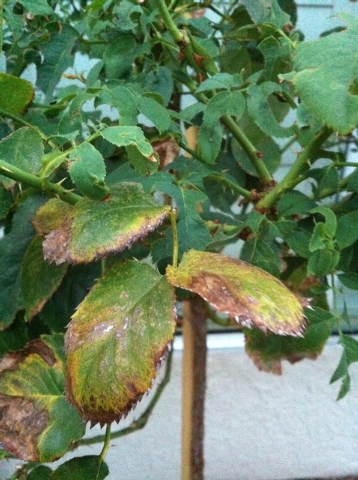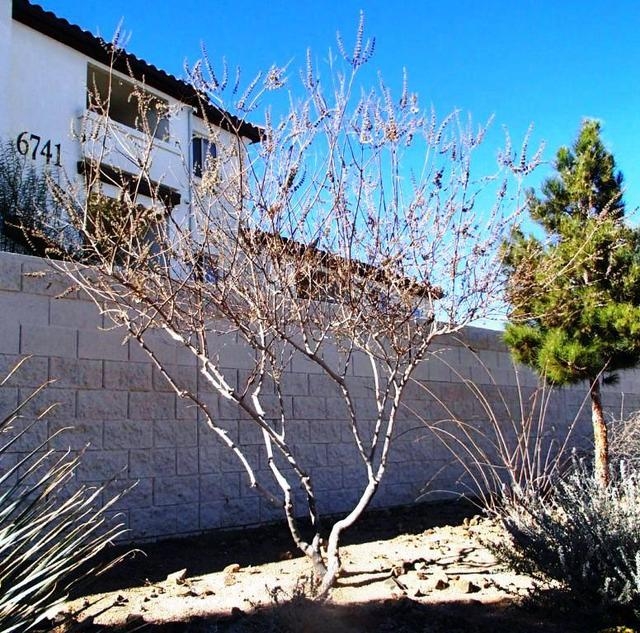Shock may have initiated leaf drop in loquat tree
Q: I have a picture of what went on with the leaves of my roses this past summer. Do you think this is black spot or rust disease of roses?
A: I really didn’t see any black spot or rust in the picture. Black spot has the typical “black spots” on the leaves with a yellow halo around them, and rust creates iron-colored pustules on the leaves that can be rubbed off on your fingers.
Both are more common during the spring, periods of high humidity and too much shade. Usually full sunlight, drip irrigation (no overhead irrigations), watering during early morning hours, fertilizing regularly and our dry conditions seldom lend themselves to either disease here.
If you need to put on a preventive treatment on roses in the spring or fall, apply one of these treatments to the leaves: sulfur dust, neem oil or compost tea.
The damage looks more like spider mites, drought or lack of fertilizer. Make sure roses have an organic surface mulch applied to the top of the soil that decomposes (wood chips), use drip irrigation, water early in the morning and apply fertilizer during the spring and fall months.
Q: The leaves closest to the trunk of my 2-year-old loquat turned yellow and fell off. Last year, the tree grew very well and produced a few loquats. This year, the amount of fruit doubled but it developed this leaf problem.
A: I cannot give you any definite answers why your loquat leaves yellowed and dropped. But I can tell you many leaves turn yellow just before they drop from the tree. This type of yellowing means the leaves have died and will drop soon.
The leaf color of loquat, without the green pigment chlorophyll, is yellow. When the tree initiates leaf drop, the leaves begin to lose their chlorophyll and hence their greenness. The remaining color after the chlorophyll disappears is yellow.
Your tree likely went through some sort of shock, which initiated leaf drop. Shock of an established tree can be related to water, salts including salts from fertilizers, a light freeze, toxic chemicals or salts such as a high concentration of fertilizer applied to the leaves, etc.
Water-related problems can stem from too much or too little water. For instance, if it went through a very dry spell, it will drop its leaves. If the soil is too wet for an extended period, it will drop its leaves. If fertilizer was applied to close to the trunk or the applied rate was too high for the plant, it will drop its leaves.
There are two types of overwatering; one is related to the volume of water the plant is given. The other relates to the frequency water is applied. By overwatering, I am referring to applying water too often, not applying too much water in a single application.
Once a week is not too often in my opinion unless you have a drainage problem.
If you don’t think the soil has been too wet, or you haven’t fertilized the tree by applying fertilizer to the soil, I would just wait and see what happens.
If you applied fertilizer to the soil and you suspect the application might have been too strong, then flood the area with water and push the salts through the soils, away from the trunk and past the roots.
Q: My large tree was damaged during a strong wind storm so that the trunk split in two. Can it be saved and how?
A: Yes, both branches can be saved or you can remove one of the larger branches. But I know removing a large part of the canopy will make it look ugly.
This type of tree repair is beyond most homeowners’ abilities. There is also the possibility of future liability if this work is done incorrectly. Repairing this type of damage is best left for professional arborists.
If you want to tackle this yourself or hire someone to do it under your supervision, then pay particular attention in getting the right supplies for this type of job. Any permanent steel that enters and stays inside the tree should be stainless. Make sure supplies you use are strong enough. Use American or Western-manufactured steel products.
Steps to repair the tree include inserting a metal rod, threaded on both ends, through the split in the trunk and cabling the limbs together using eye screws and stranded steel cable.
First, the load above the split is reduced by pruning the top.
Second, the cabling is secured with eye screws inserted into the upper limbs. Cable is never wrapped around tree limbs. The limbs are drawn together tightly.
Third, a threaded rod is inserted through the split and tightened with washers and nuts.
The tree eventually grows and engulfs the steel rod, washers and nuts. You should remember to notify anyone who might remove the tree that there is a steel rod in the interior at the split. If not, it could cause extensive damage to wood chippers or chainsaws.
More extensive discussion is posted on my blog.
Q: I have a strawberry tree that is probably getting too much sun. The leaves’ tips are very discolored. Is there anything I can do to help it?
A: The strawberry tree is native to Western Europe and the Mediterranean region. Its leaves tend to yellow because of micronutrient fertilizer problems, cold temperatures and intense sunlight. Leaves also tend to scorch on the tips in very hot locations with intense sunlight. They do not perform well in rock mulch in south or western exposures.
Getting this plant closer to optimum health helps it tolerate stresses caused by extreme soil and environmental conditions. Soil improvement and wood surface mulch will help this plant a lot.
This plant should not be in rock mulch; rock mulches radiate a lot of heat during the summer and add nothing back to the soil. If this plant is in rock mulch, I would pull the rock back a couple of feet and apply an inch or two of compost.
After lightly incorporating the compost into the upper soil surface, I would cover the exposed area with about 3 to 4 inches of wood chips. The combination of compost and decomposing wood chips will help to rebuild the soil around the roots. Rebuilding the soil around the roots improves the biological activity of the soil and overall plant health.
From your picture, the foliage looks healthy except for its scorched leaf tips. I would guess it is getting adequate amounts of fertilizer.
Applying fertilizers regularly to desert soils is frequently not enough to provide a plant with optimum health. Be sure to add an iron chelate such as EDDHA in a spring application of fertilizer once a year. The combination of the right kind of fertilizer, soil improvement and wood surface mulch will bring this plant closer to optimum health and better tolerance for hot locations
Q: When should a Vitex tree be trimmed and how much should be cut?
A: Vitex blooms in early summer through late June or July. If this plant is pruned with a hedge shears you will likely affect how it blooms this summer.
Any pruning done now should selectively remove entire branches back to a crotch. This is a pruning technique called “drop-crotching.” This technique reduces the size of a plant while still retaining its natural form. Drop-crotching avoids plant injuries due to “topping.”
Limbs that add height or size are removed at the juncture with a branch of smaller size. This type of limb removal maintains terminal buds at a lower height, retains flowers and maintains the architecture of the plant.
The opposite of drop-crotching is topping, or shearing the plant at a desired height or size. We do not want to do that to most trees. After reducing the size of Vitex, remove any crossed branches or broken branches and shape the tree to maintain its symmetry.
Bob Morris is a horticulture expert living in Las Vegas and professor emeritus for the University of Nevada. Visit his blog at xtremehorticulture.blogspot.com. Send questions to extremehort@aol.com.




















